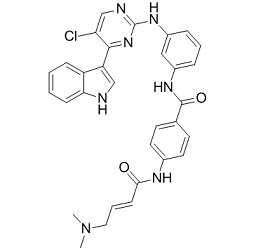All AbMole products are for research use only, cannot be used for human consumption.

In vitro: THZ1 uses a unique mechanism, combining ATP-site and allosteric covalent binding, as a means of attaining potency and selectivity for CDK7. THZ1 irreversibly inhibits RNAPII CTD phosphorylation by covalently targeting a unique cysteine located outside the kinase domain of CDK7. THZ1, but not THZ1-R, completely inhibits the phosphorylation of the established intracellular CDK7 substrate RNAPII CTD at Ser 5 and Ser 7, with concurrent loss of Ser 2 phosphorylation at 250 nM in Jurkat cells. THZ1 exhibits strong antiproliferative effects across a broad range of cancer cell lines from various cancer types. In Jurkat cells, low-dose THZ1 has a profound effect on a small subset of genes, including the key regulator RUNX1, thus contributing to subsequent loss of the greater gene expression program and cell death. THZ1 causes defects in Pol II(polymerase II) phosphorylation, co-transcriptional capping, promoter proximal pausing, and productive elongation. In vivo: THZ1 reduces the proliferation of KOPTK1 T-ALL cells in a human xenograft mouse model. THZ1 is well tolerated at 10 mg/kg with no observable body weight loss or behavioural changes, suggesting that it causes no overt toxicity in the animals.

Mol Cancer Ther. 2021 Oct;20(10):1868-1879.
Pharmaceutical Interference of the EWS-FLI1–driven Transcriptome By Cotargeting H3K27ac and RNA Polymerase Activity in Ewing Sarcoma
THZ1 purchased from AbMole

Cancer Lett. 2020 Feb 28;471:27-37.
The covalent CDK7 inhibitor THZ1 enhances temsirolimus-induced cytotoxicity via autophagy suppression in human renal cell carcinoma.
THZ1 purchased from AbMole

Cells. 2019 Nov 19;8(11).
Suppression of Angiogenesis by Targeting Cyclin-Dependent Kinase 7 in Human Umbilical Vein Endothelial Cells and Renal Cell Carcinoma: An In Vitro and In Vivo Study.
THZ1 purchased from AbMole
| Cell Experiment | |
|---|---|
| Cell lines | Jurkat, Loucy, KOPTK1 and DND-41 cell lines |
| Preparation method | Cells are treated with THZ1, THZ1-R or dimethylsulphoxide (DMSO) for 0-6 h to assess the effect of time on the THZ1-mediated inhibition of RNAPII CTD phosphorylation. For subsequent experiments cells are treated with compounds for 4 h as determined by the time-course experiment described earlier, unless otherwise noted. For inhibitor washout experiments, cells are treated with THZ1, THZ1-R or DMSO for 4 h. Medium containing inhibitors is subsequently removed to effectively 'washout' the compound and the cells are allowed to grow in the absence of inhibitor. For each experiment, lysates are probed for RNAPII CTD phosphorylation and other specified proteins. |
| Concentrations | 0-10 μM |
| Incubation time | 4 h |
| Animal Experiment | |
|---|---|
| Animal models | Bioluminescent xenografted mouse model |
| Formulation | 10% DMSO in D5W |
| Dosages | 10 mg/kg |
| Administration | i.v. |
| Molecular Weight | 566.05 |
| Formula | C31H28ClN7O2 |
| CAS Number | 1604810-83-4 |
| Solubility (25°C) | DMSO: ≥ 25 mg/mL |
| Storage |
Powder -20°C 3 years ; 4°C 2 years In solvent -80°C 6 months ; -20°C 1 month |
| Related CDK Products |
|---|
| (E/Z)-Zotiraciclib citrate
(E/Z)-Zotiraciclib citrate is a potent CDK2, JAK2, and FLT3 inhibitor. |
| Abemaciclib metabolites M2
Abemaciclib metabolite M2 (LSN2839567) is a metabolite of Abemaciclib, acts as a potent CDK4 and CDK6 inhibitor, with IC50 values of 1.2 and 1.3 nM, respectively. |
| CDK9-IN-1
CDK9-IN-1 is a novel, selective CDK9 inhibitor, with an IC50 of 39 nM for CDK9/CycT1, it can be used for the research of HIV infection. |
| XO44
XO44 (PF-6808472) is a broad-spectrum covalent kinase probe. |
| ML 315
ML 315 is a selective dual inhibitor of CDK and DYRK with IC50s of 68 nM and 282 nM, respectively. |
All AbMole products are for research use only, cannot be used for human consumption or veterinary use. We do not provide products or services to individuals. Please comply with the intended use and do not use AbMole products for any other purpose.


Products are for research use only. Not for human use. We do not sell to patients.
© Copyright 2010-2024 AbMole BioScience. All Rights Reserved.
